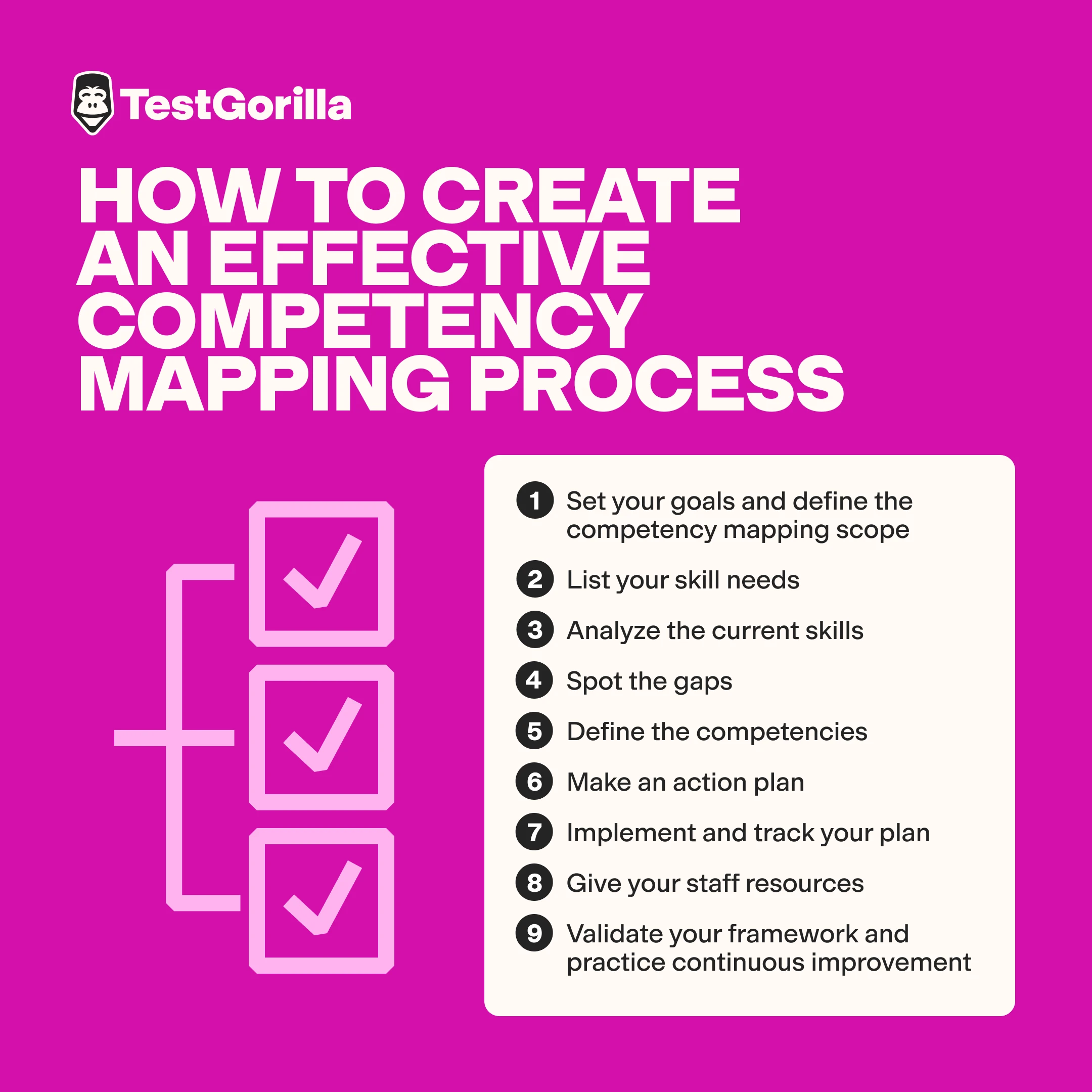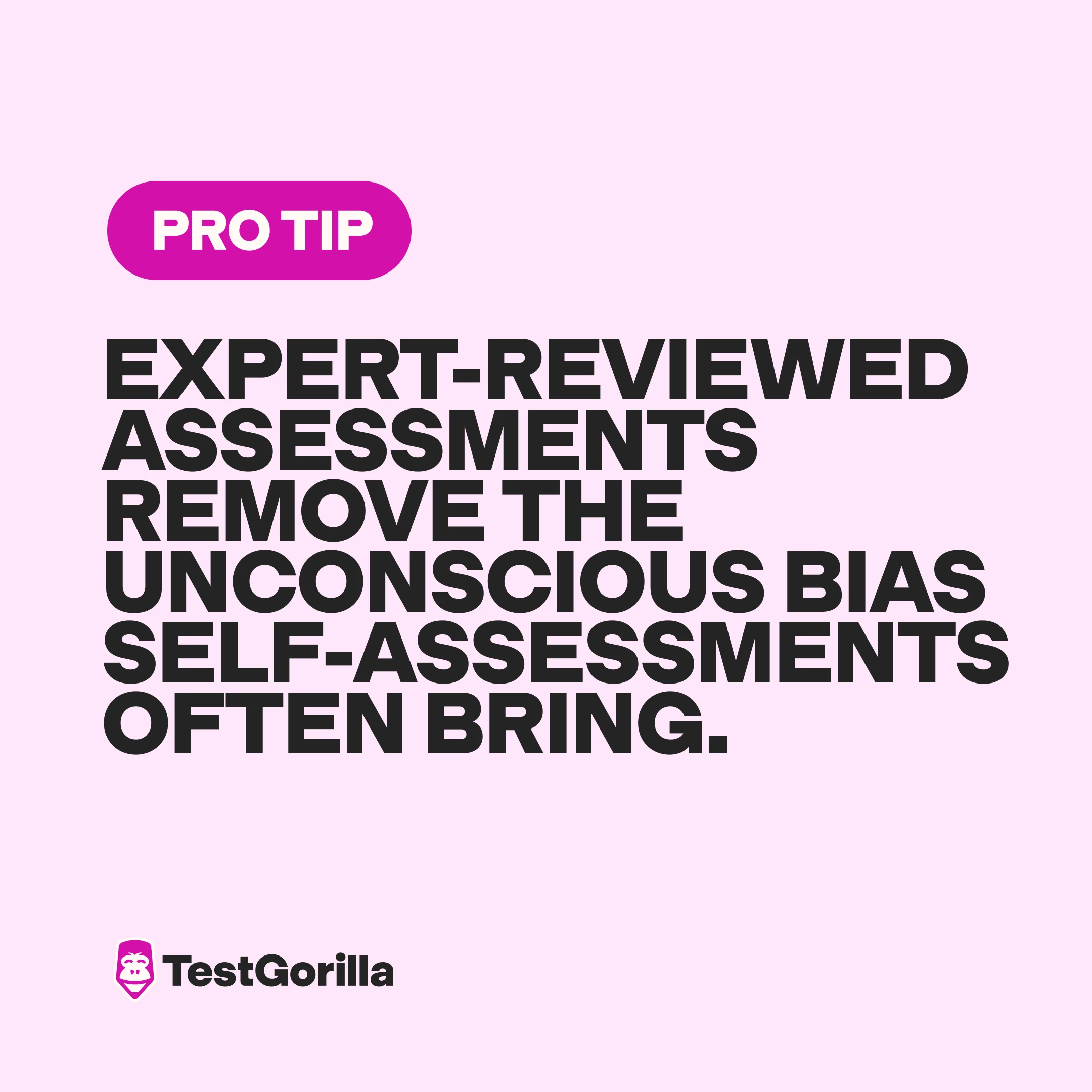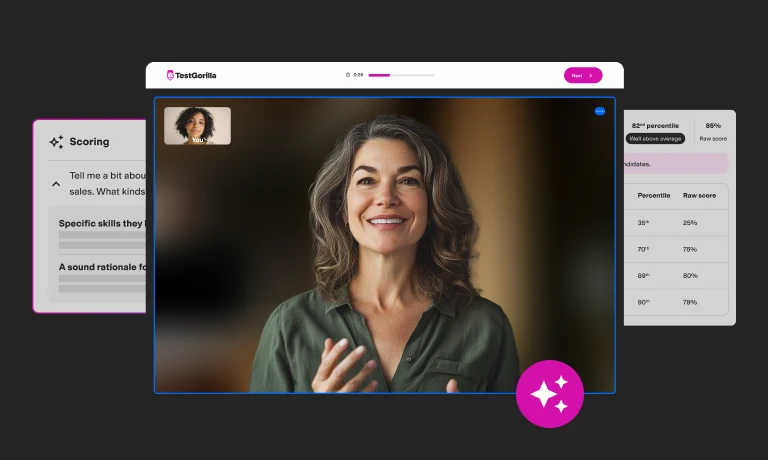Creating an effective competency mapping process is essential to ensure your team has the skills needed to hit your company’s goals. Without a solid approach, you’re likely to waste resources on a process that doesn’t truly identify skills gaps, leading to underperformance and missed targets.
Don’t worry, though! This article will walk you through building a competency mapping framework that works, helping you avoid the costly cycle of continuous underperformance. We’ve even included a free customizable template you can try out for your team.
If you're ready to figure out where your team stands and how to elevate their performance, keep reading.
Table of contents
- Step 1: Set your goals and define the competency mapping scope
- Step 2: List your skill needs
- Step 3: Analyze the current skills: Core, functional, technical, and leadership
- Step 4: Spot the gaps
- Step 5: Define the competencies
- Step 6: Make an action plan
- Step 7: Implement and track your plan
- Step 8: Give your staff resources
- Step 9. Validate your framework and practice continuous improvement
- TestGorilla’s competency mapping template
- Effective competency mapping with TestGorilla
- Boost your competency mapping process with TestGorilla
Step 1: Set your goals and define the competency mapping scope
First, figure out what goals your company wants to achieve. For instance, are you trying to improve your training programs, lean into career development, boost employee performance and engagement, or revamp your recruitment procedures? You’ll want to align the competency mapping process with your organization's mission, vision, and strategic objectives.
After naming your objectives, confirm the scope of your competency mapping – whether it’s companywide, one department, or a few employees. This way, you can create a targeted and manageable plan to address the most important competencies first. Confirming the scope helps you allocate the right resources and set realistic timelines for the competency mapping process.
For example, if you're a tech startup aiming to become a leader in AI, you need to focus on competencies related to AI development, data analysis, and machine learning. Therefore, you’ll want to focus on your development team first. Understanding these goals helps you identify which skills are must-haves for success.
Step 2: List your skill needs
Next, list all roles in your company and the skills each role requires. Start by categorizing roles and breaking down each one to understand its core responsibilities and the competencies your staff needs to perform them effectively.
This step helps you prioritize skills that directly impact your organization’s success. Don’t forget to keep your project’s scope in mind to maintain focus and relevance while doing this.
For example, a digital marketing manager may need SEO, content creation, social media strategy, and data analytics skills. Conducting a needs assessment ensures you know exactly what you're looking for, so you don’t accidentally miss critical skills.
Further reading: How to perform a skills gap analysis to identify and bridge talent gaps
The best insights on HR and recruitment, delivered to your inbox.
Biweekly updates. No spam. Unsubscribe any time.
Step 3: Analyze the current skills: Core, functional, technical, and leadership
Once you've identified the skills your company needs, it's time to analyze the skills your team already has. This is how you’ll understand the gaps between your current competencies and the skills required to achieve your organizational goals. The analysis should be thorough, covering core, functional, technical, and leadership competencies.
Core competencies
Core competencies are the fundamental skills and behaviors that align with your company's values and culture. These may include communication, teamwork, adaptability, and problem-solving.
Use tools like self-assessments or 360 evaluations with skills tests to assess core competencies. For example, you might ask employees to evaluate their own communication skills or take TestGorilla’s Communication test.
Top tip: Expert-reviewed assessments remove the unconscious bias self-assessments often bring.
Functional competencies
Functional competencies are specific to a role or department. These could include project management skills for your team leader or budgeting expertise for your finance manager. To evaluate their functional competencies, consider taking a skills-based approach.
For instance, our Project Management test can assess your employees’ project management skills, and our Budgeting test is perfect for finance managers. Pair either test with a performance review of your employees’ past projects, and you’ll have an accurate idea of their skill level in that role.
Technical competencies
Technical competencies are job-specific skills that are often measurable and quantifiable. For instance, within a software development team, these may include proficiency in programming languages, software tools, or system architecture.
Assessing technical competencies can involve reviewing performance histories, conducting technical tests, and using peer evaluations. TestGorilla’s extensive library of technical assessments, along with our language-agnostic coding challenges, can be particularly useful.
These assessments provide objective data on your team’s technical abilities, helping you identify areas for improvement.
Psst! Read more about our language-agnostic coding tests here.
Leadership competencies
Leadership competencies are crucial for those in management or supervisory roles. These include strategic thinking, decision-making, team leadership, and conflict resolution.
To evaluate leadership competencies, consider adding TestGorilla’s Leadership and People Management test to your arsenal. This test helps you understand employees’ motivation, support, and team development skills.
Step 4: Spot the gaps
Now that you know where your team stands, it’s time to spot the gaps between what you’ve got and what you need. This is where a competency matrix comes in handy. It’s like a visual map showing exactly where each employee’s skills align with your desired competencies – and where they fall short.
For example, if your customer support team is killing it in communication but struggling with technical troubleshooting, that’s a gap you can’t ignore. Using a competency matrix makes it easy to see these gaps at a glance and figure out where to focus your development efforts.
Step 5: Define the competencies
After identifying the gaps, the next step is clearly defining the competencies needed for each role. You’ll want to be specific about the must-have skills and behaviors for success in each position.
For example, if you’re looking at a project manager role, you’d define competencies like leadership, risk management, and effective communication. But don’t just list them – get into the details of what each competency really means in your company's context.
When you clearly define these competencies, you set the stage for everything else – performance evaluations, development plans, and even hiring decisions. Well-defined competencies help employees understand exactly what’s expected of them and how they can grow. This clarity is how you’ll drive performance and align everyone with your organization’s goals.
Step 6: Make an action plan
Now that you’ve identified the gaps and defined your competencies create an action plan to bridge those gaps. This could mean hiring new talent, rolling out training programs, or even reshuffling responsibilities within your team. Be sure to set clear objectives, timelines, and follow-up plans to keep everything on track.
For example, if boosting digital marketing skills is a priority, you might hire a digital marketing expert or train your current team on the latest SEO trends.
Step 7: Implement and track your plan
With your action plan ready, it’s time to put it into motion and keep a close eye on progress. Start by implementing the changes you’ve outlined – whether that’s new hires, training programs, or shifting responsibilities. But don’t just set it and forget it; conduct periodic reviews to monitor how things are going.
By setting clear, measurable metrics, you can gauge the success of your competency mapping efforts. If you’ve rolled out a training program for your sales team, track key metrics like sales conversion rates and customer satisfaction scores to see if there’s an improvement. Regular check-ins are a must; they allow you to adjust the plan as needed to ensure it’s still on track.
Step 8: Give your staff resources
To ensure the success of your competency mapping efforts, you must give your employees the right tools and resources. This may mean providing access to online learning platforms, hosting workshops, or introducing new software that aligns with the skills they need to develop.
For example, if your IT team needs to stay ahead in cybersecurity, ensure they have access to courses on the latest protocols and technologies.
Investing in your team’s development isn’t just about filling gaps – it’s also about boosting engagement and retention. Deloitte reports that employees with access to learning and development resources are likelier to stay engaged and stick around longer. So, think of this step as an investment in both your team’s growth and your company’s future success.
Step 9. Validate your framework and practice continuous improvement
You’ll need to involve the right people in the process to keep your competency framework relevant and effective. This means getting input from department heads, top management, and functional experts through workshops, feedback sessions, and consultations.
For example, before you lock in the competencies for a new role, get insights from the relevant departments to ensure everything is spot-on and comprehensive. Since competency mapping isn’t something you do once and forget about, you should treat it as a living, breathing process.
Regularly review and update your framework to keep pace with your organization’s evolving goals and industry changes. For instance, set up an annual review to factor in new technologies and methodologies so you’re always ahead of the curve. Stay flexible, watch what the data tells you, and be ready to adjust as needed.
TestGorilla’s competency mapping template
Here’s a customizable competency mapping template you can use for your organization.
Competency mapping template
Step 1: Define the Role
Role Title:
Department:
Date:
Step 2: Identify Key Responsibilities
Key Responsibility | Description |
Responsibility 1 | Describe the key task or duty associated with the role |
Responsibility 2 | Describe the key task or duty associated with the role |
Responsibility 3 | Describe the key task or duty associated with the role |
Step 3: List Required Competencies
Competency | Description | Importance Level (1-5) |
Technical Skills | Specific technical skills needed for the role | 4 |
Communication | Ability to effectively convey information and ideas | 5 |
Leadership | Ability to lead and manage teams | 3 |
Problem-Solving | Ability to identify and solve issues efficiently | 4 |
Time Management | Ability to manage time and prioritize tasks | 4 |
Step 4: Assess Current Competencies
Employee Name | Competency | Current Level (1-5) | Notes on Current Level |
John Doe | Technical Skills | 3 | Needs improvement in specific software tools |
Jane Smith | Communication | 5 | Excellent in both written and verbal communication |
Sam Johnson | Leadership | 2 | Needs development in managing team projects |
Step 5: Identify Competency Gaps
Competency | Gap Description | Plan to Address Gap |
Technical Skills | John needs training on software tools | Enroll John in an advanced software training course |
Leadership | Sam needs development in team management skills | Provide Sam with leadership training and mentoring |
Step 6: Create Action Plan
Training Programs:
Advanced software training for technical skills
Leadership workshops and mentoring
Hiring Needs:
Consider hiring for advanced technical roles
Recruit experienced team leaders
Timelines and Follow-Ups:
Quarterly reviews of progress
Regular check-ins with training and development teams
Step 7: Implement and Monitor
Implementation Date: Monitoring Schedule:
Monthly progress meetings
Quarterly skill assessments
Step 8: Review and Update
Next Review Date: Updates Needed:
Add new competencies as industry standards evolve
Adjust training programs based on feedback
Effective competency mapping with TestGorilla
Using skills-based assessments instead of self-assessments in your competency mapping gives you clear, unbiased insights into your team's actual skills. This way, you're not just relying on how people think they perform; you're working with real data that tells the true story.
This approach also enables you to make data-driven adjustments based on what’s really happening, which keeps your competency mapping accurate and effective. As a result, you’ll develop a skills-based workforce.
TestGorilla is the perfect tool to make this process seamless. Our comprehensive skills assessments help you objectively evaluate your team’s current competencies against the required benchmarks. You’ll be able to highlight skills gaps in specific areas based on your employees’ results and make plans for improvement.
Whether you're assessing technical skills or leadership capabilities, using a combination of up to five of TestGorilla’s tailored, customizable tests ensures that your competency mapping is both accurate and aligned with your organization’s goals.
Boost your competency mapping process with TestGorilla
Competency mapping helps you align your team’s skills with your organization’s goals. You'll need to set clear objectives and define the scope, whether it’s company-wide or just one department. Then, identify each role's skills and analyze your team’s current competencies to expose any gaps. Afterward, you’ll create an action plan to close those gaps and keep track of progress.
TestGorilla boosts this process by offering a library of more than 350+ data-driven tests that accurately show your team’s abilities, helping your organization stay aligned with its strategic goals.
Ready to improve your competency mapping? Book a 45-minute free demo, and sign up for your free account today.
You've scrolled this far
Why not try TestGorilla for free, and see what happens when you put skills first.




















